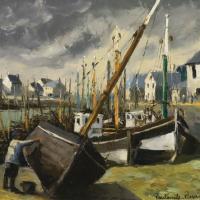Paul-emile Pissarro
Port En Bessin Mar E Basse
$450.00
Paul-emile Pissarro
Paul-Emile Pissarro (1884-1972)
Paul-Émile Pissarro , born on August 22 , 1884 in Éragny ( Val-d'Oise), died on January 20 , 1972 in Clécy ( Calvados ), is a French painter.
Paul-Émile Pissarro is the fifth and last son of Camille Pissarro and Julie Vellay . Raised in an artistic household like his brothers, it seems that he was the best predisposed to painting: a white horse, drawn at the age of five, received praise from the writer Octave Mirbeau , his father, impressed , decided to keep him apart in his private collection, since then he will not stop supporting him in what becomes his passion.
In 1899, Paul-Émile Pissarro went to school in Gisors ( Eure ), but stopped after a few months to accompany his father on an artistic trip to Le Havre , Dieppe and Rouen . During the last years of his father's life, his family lives in Paris , where Paul-Émile studies in a private art academy, this marks the difference of course with that of his brothers and sisters who have benefited most from the tutoring of their father.
After the death of his father in 1903, he returned to live with his mother in their summer home Éragny , about thirty kilometers from Giverny where resides his godfather Claude Monet . Monet, who was very close to Camille, becomes his tutor and friend. He often visited Giverny, where Monet gave him lessons in painting and horticulture, encouraging him in his father's footsteps: "Work! Search! Do as your father did. » In 1905 , with his brother Ludovic-Rodo Pissarro , he began at the Salon des Independants (said that year The Salon des Fauves ) with its landscape Edges of the Epte Eragny .
The years 1908-1914 are difficult. In 1908 he worked as a mechanic and test pilot , then as a designer of textiles and laces, an activity that gave him some free time to devote to painting. While working at the lace factory, his brother Lucien Pissarro , then in London , asked him to send him some watercolors . The interest shown by British enthusiasts encourages him to start painting again. With his young wife, Berthe Bennaiché, he moved to Burgundy .
Reformed during the First World War because of his poor health, Paul-Émile Pissarro took advantage of the war years to travel and paint, especially in the north of France. In a letter to Lucien in 1916 he wrote "I saw great things, I'm full of enthusiasm" . With the help of his brother, he exhibited in London , the New English Art Club , the Baillie Gallery and the Allied Artists Association .
The painting of Paul-Émile Pissarro was influenced by Paul Cézanne whom he had met several times in Paris .
In the 1920s , with his artist friends Kees van Dongen , Maurice de Vlaminck , André Dunoyer de Segonzac and Raoul Dufy , he traveled during the summer, painting in the French countryside and returned to Paris for the winter.
In 1924 , he bought a house in Lyons-la-Forêt.
( Eure ), whose garden (which Monet draws ), the surrounding countryside and the Epte inspired his paintings.
His style became clear in the late 1920s: mixed tones and use of the knife to paint. He works on a boat workshop.
He practices wood engraving and etching , some prints are published by Malcolm Salaman in 1919.
In 1930, on the recommendation of Raoul Dufy, Paul-Émile Pissarro visited Norman Switzerland . He immediately fell in love with this region of Calvados , and particularly the Orne, which offered him new motifs for the paintings he sent to the Salon des Indépendants for the next thirty years.
After the divorce with his first wife, he moved in 1934 to Norman Switzerland. Two years later he bought a house in Clécy with his second wife, Yvonne Beaupel, with whom he had three children, Hugues Claude, Yvon and Vera. Both sons became artists. In 1967, Paul-Émile Pissarro exhibited individually for the first time at the Wally Findlay gallery in New York .
Paul-Émile Pissarro died on January 20, 1972 in Clécy .
Paul-Émile Pissarro practices portraiture and landscape. He paints the small towns of the Midi like Treignac and Uzerche , the Norman forest and the Poitevin marsh .



